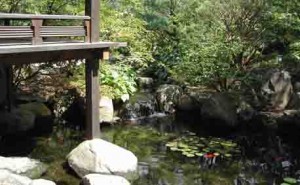Japanese Koi Pond and the Izumi-dono Effect
 April 26, 2012
April 26, 2012
If you have the desire to incorporate the architecture on your site into your garden, or if you simply have a wish to add an air of grace to structures in your garden, you will probably find this technique to be of help. The effect developed as long piers built for fishing and relaxing and located predominately on the estates of wealthy members of society. Izumi-dono, as it exists today primarily described the act of extending the corner, or portion of a building or deck over a body of water, whether it be a lake, a pond, or even a small stream, and resting it on a unobtrusive pier designed to interact with the buildings foundation holding it aloft. The picture shown here is from a public Japanese garden (not a Niwa Design Studio) illustrates this effect.
Many people will say “doesn’t that take the focus of the garden and place it on the building?â€Â This is a valid question, but you should think of it as any other ornament or structure you have on site. The Effect in itself is the expression of the desire for the architecture to melt into the surrounding landscape more seamlessly. This is done by retaining a view from within unobstructed by window ornament, furniture, curtains, railings, even plants. Creating the unobstructed view and treating the interaction of interior and exterior with reverence is paramount to the success of your project.
While this effect does take a good deal of engineering, and most likely budget to attain, the proper integration of the built and natural environs is an incredible addition to your site allowing a view of your garden from your room, or even rooms extending over your body of water.
If you would like our help with your Japanese garden project please contact us, Niwa Design Studio, at 952-470-1882.
You can also visit Japanese Garden Journal for more information about Japanese Gardens.

 Posted in
Posted in  content rss
content rss